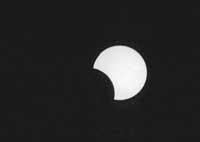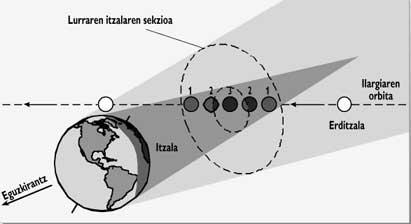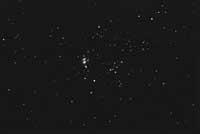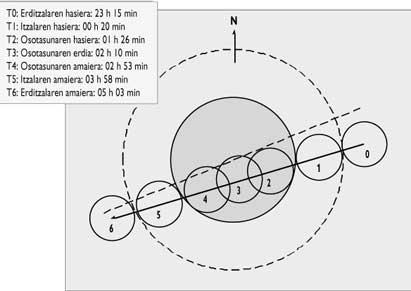Attention to the April eclipse!
Causes of the phenomenon
In order to see the eclipse of the Moon, three conditions must be met: the first is that the Sun, the Earth and the Moon are in the same plane; the second, that the three are aligned and, therefore, in the case of the eclipse of the Moon can only occur with the Full Moon; and the third, that in the hours of the eclipse has night in our region. When this happens, the Moon enters the shadow zone that the Sun exerts behind the Earth and darkens. Three main phases can be distinguished in the lunar eclipse (see figure 1).

To begin with, the Moon occurs when it enters labor, but without proper tooling it is very difficult to realize it. The second phase is more visible, as when the Moon enters the shadow we will see that the shadow of the Earth "eats" its satellite. However, the most spectacular phase of the eclipse is the third, in which the Moon is completely covered.
The eclipse of the Moon will not require any type of apparatus, that is, it can be seen at first sight without any protection (unlike the eclipses of the Sun). However, it is also known that with binoculars and/or telescopes we can see them better. On the other hand, you have to be careful when using the equipment, since when the Moon is full before the eclipse starts, we can damage our eyes.
Chronological eclipse
The Sun hides at 20.39, while the full Moon appears in the east. Two and a half hours later, at 23.15, the Moon will have to the Southeast a height of 27° above the horizon. It is the time when the eclipse begins. During the process, the Moon is at a height of between 30º and 40º, so the eclipse can see complete.
As mentioned above, in the first phase the Moon will enter into childbirth. As already mentioned, we will hardly realize it, since the shadow of the Earth remains very weak, while with the use of binoculars or telescope can be observed that the brightness of the Moon is fading.

The second phase, that is, the phase since the Moon enters the shadow until it hides completely, will begin at 20 minutes midnight. From the beginning of this phase we will realize that, as soon as the Moon enters the shadow, the Earth will begin to “eat” her face. In addition, we remind you that we can see it without any help.
The third phase or joint phase will take place in 1.26, when the Moon will be totally immersed in the shadow of the Earth. This phase will last 86.5 minutes. These minutes are the most interesting, since the Moon is illuminated with spectacular colors and change throughout the phase and according to the terrestrial atmosphere. However, and as can be seen in figure 2, the Moon will pass very close to the center of the shadow, which makes us think of a rather dark eclipse. We will later explain the criteria used to measure darkness and promise that it will be an exercise to generate debate among us.
On the other hand, we must bear in mind that during the eclipse we will see more stars around the Moon than when the Moon was not eclipsed. And is that the constellation of Virgo that will happen the phenomenon is very rich in stars and will offer us a great opportunity to take spectacular photos. Throughout this phase, the Moon is to the south and at a height of 40º, so all conditions are very suitable for these tasks.
After the last phase, in 2.53, the Moon will begin to take its initial appearance. From there we can review the process we have already observed, but vice versa. The Moon leaves the shadow zone at 3.58 hours and gives birth at 5.03 hours, when the Moon eclipse ends.
For all of the above, you may think that April is an option that cannot be missed. But let's not worry too much because this same year and in Euskal Herria we will have the opportunity to see two other eclipses. The first will be the other total lunar eclipse, very similar to the one described. It will be on September 27, the night from Thursday to Friday. And the other will be a partial eclipse of the Sun that hides half of the Sun. The last eclipse of this type occurred in May 1994 and this year will take place on October 12 at noon.

Observations
We wish you to enjoy the possibilities offered by these shows. Do not forget that when the Moon eclipse occurs it is a good time to make observations and get ready for it.
Timing
Moon eclipses offer a wide variety of observations. One of these observations or exercises is the beginning and end of the phases and timing in which the shadow of the Earth touches several craters of the Moon. Although it is out of curiosity, an interesting exercise is to contrast during the eclipse the times that appear in the table in Figure 2. Although the edge of the shadow is not very clear, these observations allow us to calculate the value that can be considered as the radius of the Earth. Thus, it is observed that the shadow of the Earth is 2% higher than its own, and that this deviation is due to the influence of the atmosphere. Therefore, when making observations, we must be very careful. The clock must be kept at an exact time and the telescope must collect the hours when the shadow touches the main craters.

Normally in this type of eclipses the Moon does not darken enough not to see its face. Shows a red-brown color with solar rays refracted by the atmosphere
The factors that influence the dark of the eclipse are many and, as we have already said, the phase of totality is expected to be dark, although it is not known exactly how it will be. To measure the darkness you can use two simple methods: the first is the “Danjon grade scale” and the second, the method based on the specifications we see the surface of the Moon. Both must be performed in the entire phase of the eclipse.
As for the first method, we must carefully observe the Moon and assign a grade according to the data indicated in the following table. The second method has three levels. However, it is not as used as Danjon.
- Clear eclipse: Moon details (craters, seas, etc.) are visible to the naked eye.
- Dark eclipse: Moon specifications are seen through binoculars but not in sight.
- Very dark eclipse: Moon specifications are only seen by telescope.

Photo of the eclipse
When we are facing an eclipse, it is difficult to give up taking pictures and that is what attracts many. In fact, you can take spectacular photos surrounded by an extraordinary color of the Moon in its phase of fullness and stars that we could not see without eclipses.
Grade 0 Very dark eclipse. You barely see the Moon. The details of the Moon are hardly appreciated. Dark grey or black. Grade 1 Dark eclipse. Moon specifications are seen with difficulty. Gray or brown. Grade 2 Color: dark red. The Moon appears with the darkest center and the brightest edges. Grade 3 Color: red or orange. The edge of the Moon is yellow. Grade 4 Bright eclipse. Color: yellow orange and bluish edge.
As its color is evident in a lunar eclipse, it is logical to use a colored film. Keep in mind that if you take it out with the normal lens of a 50 mm camera, the moon will look very small in negative. However, interesting photos can be taken. For example, by placing the camera on the tripod, if you photograph every 20 minutes on the same negative (or slide), you will get the sequence of the different moments of the eclipse.
For the Moon to rise larger, it is recommended to use larger objectives, as this way we will get superficial details. However, it is best to take photos with a telescope, even if they are small. The sensitivity of the film we are going to use is also very important. In the table above, two variables were taken into account for calculating exposure times: on the one hand, the objective diagram or telescope and on the other, the sensitivity of the film. Our last advice is not to forget the movement of the Moon. And because of its journey through the sky, if a prolonged exposure is used, the photo will be moved.





